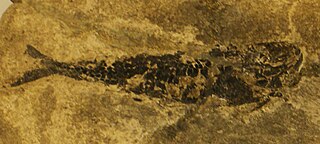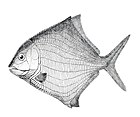
In the geologic timescale, the Olenekian is an age in the Early Triassic epoch; in chronostratigraphy, it is a stage in the Lower Triassic series. It spans the time between 251.2 Ma and 247.2 Ma. The Olenekian is sometimes divided into the Smithian and the Spathian subages or substages. The Olenekian follows the Induan and is followed by the Anisian.

The Induan is the first age of the Early Triassic epoch in the geologic timescale, or the lowest stage of the Lower Triassic series in chronostratigraphy. It spans the time between 251.9 Ma and 251.2 Ma. The Induan is sometimes divided into the Griesbachian and the Dienerian subages or substages. The Induan is preceded by the Changhsingian and is followed by the Olenekian.

Birgeria is a genus of carnivorous marine ray-finned fish from the Triassic period. Birgeria had a global distribution, with fossil known from Madagascar, Spitsbergen, Germany, Switzerland, Italy, Slovenia, China, Russia, Canada and Nevada, United States. The oldest fossils are from Griesbachian aged beds of the Wordie Creek Formation of East Greenland. Birgeria existed throughout the entire Triassic period, from the very beginning just after the Permian-Triassic mass extinction, up to the very end with its extinction during the Triassic-Jurassic mass extinction.
Laugia is an extinct genus of coelacanth fish which lived during the Induan age of the Early Triassic epoch in what is now Greenland. The type and only species, Laugia groenlandica, was collected from the Wordie Creek Formation and described by Erik Stensiö. The genus is named after Lauge Koch.

Fadenia is an extinct genus of eugeneodontid holocephalian chondrichthyan from the Carboniferous Period of Missouri, the Permian period of Greenland, and the Early Triassic epoch of British Columbia, Canada.
Wimania is an extinct genus of coelacanth lobe-finned fish that lived during the Early Triassic epoch in what is now Svalbard. Fossils were found in the Smithian aged "Fish Niveau" of the Lusitaniadalen Member of the Vikinghøgda Formation. Wimania belongs to the family Coelacanthidae. It is named after Carl Wiman.

Australosomus is an extinct genus of prehistoric ray-finned fish that lived during the Early Triassic epoch in what is now Greenland, Kenya, Tanzania, Madagascar, South Africa and Canada.
Helmolepis is an extinct genus of ray-finned fish that lived during the Early Triassic epoch in what is now Greenland, Madagascar and Canada. Species of Helmolepis are small. This genus is closely related with Platysiagum.

Besania is an extinct genus of prehistoric marine ray-finned fish that lived during the Anisian and Ladinian ages of the Middle Triassic epoch in what is now southern/southeastern Switzerland and northern Italy. Fossils were recovered from the Besano Formation of Monte San Giorgio area and the Prosanto Formation of canton Graubünden, Switzerland.
Sassenia is an extinct genus of prehistoric coelacanth lobe-finned fish that lived during the Early Triassic epoch in what is now East Greenland and Svalbard.

Ptychoceratodus is an extinct genus of lungfish living from Early Triassic to Middle Jurassic. It was established by Otto Jaekel for one species, transferred from Ceratodus genus. Type species is P. serratus from the Middle Triassic of Switzerland and Germany. Ptychoceratodus had two pairs of massive dental plates, bearing 4-6 acute ridges. Its skull roof was composed from massive, plate-like bones. In the central part of skull roof was localized an unossified fenestra. Most of the Ptychoceratodus findings are isolated dental plates, some associated with jaws. Other parts of skull or postcranial skeleton are relatively rarely found as fossils. The anatomy of skull is the best recognized in P. serratus, whereas less complete cranial material is available also for P. concinuus, P. phillipsi, and P. rectangulus. Although Ptychoceratodus is known exclusively from the Triassic and Jurassic, there were also Cretaceous specimens referred to this genus. However, they are more often regarded as representants of Metaceratodus. Ptychoceratodus is the only member of the family Ptychoceratodontidae. The first named species is P. phillipsi by Louis Agassiz in 1837 as a species of Ceratodus and later moved to Ptychoceratodus genus. Occurrences of Ptychoceratodus come mainly from Europe. However, occurrences from other continents suggest it was dispersed globally during the Triassic. After 2010, the new fossil material behind the Europe was reported from South America, India, and Greenland
Alleiolepis is an extinct genus of prehistoric bony fish, which lived during the Ladinian age of the Middle Triassic epoch in what is now Franconia, Germany. It is generally considered a semionotiform. It was first named Leiolepis, but because this genus name is preoccupied by an extant lizard, the genus name of the Triassic fish was changed to Aleiolepis.

Boreosomus is an extinct genus of Triassic marine ray-finned fish. It was first described from the Arctic island of Spitsbergen, hence its genus name, but was later also discovered in other parts of the world. The type species is Boreosomus arcticus.

Colobodus is an extinct genus of Triassic bony fish of the family Colobodontidae and order Perleidiformes. Fossils have been found in Europe and China. It could reach body lengths of about 70 cm.

Sargodon is an extinct genus of neopterygian ray-finned fish that lived during the Middle and Late Triassic epochs in what is now Europe.

Meridensia is an extinct genus of prehistoric ray-finned fish that lived during the Anisian and Ladinian ages of the Middle Triassic epoch in what is now southern Switzerland and northern Italy. Fossils were recovered from the Besano Formation of Monte San Giorgio and Besano area at the Swiss-Italian boundary.

Bobasatraniiformes is an extinct order of durophagous ray-finned fish that existed from the late Permian to the Middle Triassic in both marine and freshwater environments. The order includes two families: Bobasatraniidae, with the genera Bobasatrania, Ebenaqua, and Ecrinesomus, and Dorypteridae, comprising only the genus Dorypterus (monotypy). Bobasatraniiformes had a somewhat global distribution; fossils are found in Africa (Madagascar), Asia (Pakistan), Australia, Europe, and North America.
The Wordie Creek Formation is an uppermost Permian and Lower Triassic geologic formation in Greenland, outcrops of which are located in Northeast Greenland National Park. In 2017, it was suggested to be raised to group status, as the Wordie Creek Group.

Parasemionotiformes is an extinct order of neopterygian ray-finned fish that existed globally during the Triassic period. It comprises the families Parasemionotidae and Promecosominidae. Many of the included genera are monotypic and most species lived during the Early Triassic epoch.
Eigil Hans Aage Nielsen was a Danish paleontologist, who specialized in fossil vertebrate anatomy, particularly of Triassic bony fish.


























